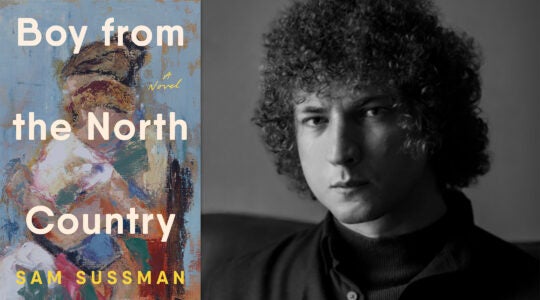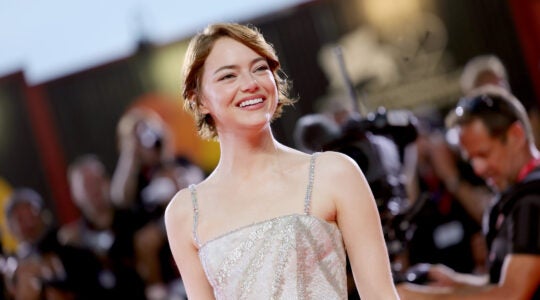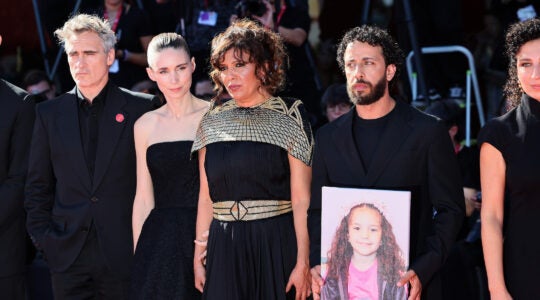On the heels of a trio of comments that have sent the pro-Israel world into a frenzy, the White House opened its doors last evening to Jewish leaders and others for its annual Hanukkah reception.
More than 500 guests packed into the White House’s Grand Foyer to munch on vodka Scottish smoked salmon (whatever that is) and fresh sushi rolls as they listened to President Barack Obama discuss the importance of Hanukkah — and the U.S.-Israel relationship.
"This Hanukkah season we remember a story so powerful that we all know it by heart — even us Gentiles," Obama told a crowd that included Israeli Ambassador Michael Oren and Supreme Court Justice Justice Ruth Bader Ginsburg. "It’s a story of right over might, of faith over doubt. Of a band of believers who rose up and freed their people and discovered that the oil left in their desecrated temple — which should have lasted only one night — ended up lasting eight."
The president — who was flanked by his wife, Michelle, and Vice President Joe Biden — also affirmed the "friendships" that exist between the United States and Israel.
"This is also a time to be grateful for our friendships, both with each other and between our nations," he said. "And that includes, of course, our unshakeable support and commitment to the security of the nation of Israel."
The line elicited ample applause from those in attendance.
As he has in past years, Rabbi Levi Shemtov, director of American Friends of Lubavitch, supervised all preparation of the food to ensure it met the highest standards of kashrut.
"The White House works diligently to ensure that we don’t have to compromise on any standard of kashrut," Shemtov told me as we waited for the president to hit the podium. "And we work as diligently to ensure that the White House does not have to compromise any of the standards of presentation."
Judging from the way attendees hit those sushi rolls and other munchables, it seems the kosher food was a hit.
Here’s the full menu, per the White House:
Dill and Vodka Scottish Smoked Salmon
Non-Pareil Capers
Chopped Egg Whites
Chopped Egg Yolks
Parsley
Lemon WedgesAssorted Fresh Sushi Rolls
Roulade of Chicken Breast
Arugula and Fresh Artichokes
Garlic Mashed Potatoes
Fresh Thyme SauceFilet of Beef
Caramelized Pearl Onions
Shitake Mushrooms
Au JusPine Nut Herb Crusted Lamb Chops
Mango and Mission Fig ChutneyHomemade Potato with Scallion Pancakes
Apple SauceWinter Squash Salad
Assorted Rolls
Dessert Station:
Homemade Soufganyot
Crème Anglaise
Raspberry Jelly
Also, take note of the menorah that was on display (see the photo). Here’s some background, courtesy of the White House:
The menorah for this year’s ceremony was lent by The Jewish Museum, New York. It was created in a displaced persons’ camp after World War II. The residents were receiving vocational training from ORT, a Jewish organization active throughout Europe. Begun in Russia in 1880 to provide funds for needy Jews, by the 1920s ORT had turned to training Jews in manual labor as a means of changing their economic conditions.
The lamp is dedicated to General Joseph T. McNarney, who served as the Commander in Chief of United States Forces in the European Theatre from November 1945 to March 1947. As such, he was responsible for the displaced persons camps in Germany and Austria. This lamp was presented to him shortly after he took office, perhaps at a visit to the camp. McNarney was considered kind-hearted and humane, and when Jews fleeing postwar pogroms in Poland infiltrated illegally into the American-controlled sector, he granted them shelter and care. In addition, General McNarney enabled the publication of a complete edition of the Talmud to meet the thirst for Jewish education among surviving European Jews. Acceding to the impassioned plea of Rabbi Philip S. Bernstein, the American advisor on Jewish affairs, McNarney scrounged for scarce paper, imported sets of the Talmud from America to make offset copies, and requisitioned a printing plant to publish the edition, which came out in 1948.
The Hebrew inscription on the lamp, "A great miracle happened there," is found on the tops or dreidls that children play with on Hanukkah in Ashkenazi communities. It refers to the miracle of Hanukkah, but may in this instance also poignantly signify the liberation and salvation of the Jews in the DP camp.
JTA has documented Jewish history in real-time for over a century. Keep our journalism strong by joining us in supporting independent, award-winning reporting.





